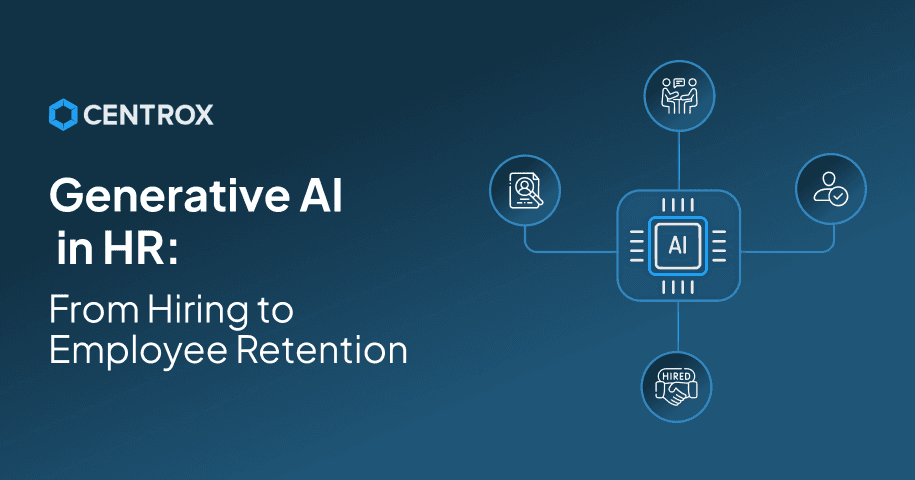Generative AI in HR Processes: From Hiring to Employee Retention
Understand how Gen AI transforms HR by improving hiring and retention, and discover models and applications that streamline processes.
8/4/2025
artificial intelligence
8 mins

Managing resources, especially humans, can be very challenging. Human resource management is the basis of any business or organization. The traditional way for human resource management isn't just time-consuming, but it's also very frustrating. Here introduction of a generative AI-driven solution can serve as a reliable assistant in handling some responsibilities.
In recent years, where expectation patterns have been evolving, time has emerged as a major element that provides businesses with a competitive edge. Therefore, time efficiency and effectiveness of any service, product, or solution can not be ignored. A generative AI-powered solution for managing human resource processes indeed has great potential in speeding up redundant tasks, making hiring, onboarding, and employee management more streamlined.
In our guide will discuss how generative AI works for handling HR processes, some common HR applications it can handle, along with shedding some light on the impact and limitations of these generative AI solutions. This will help you get a better overview before planning the adoption or integration of such solutions.
Generative AI in HR Processes
A generative AI solution for HR processes contributes to automating the daily responsibilities of the human resource sector. Such an AI-driven tool can screen resumes, make a precise job description, along with doing employee performance analysis. These tools can uplift decision-making and user experience by providing fast, efficient, and smarter recruitment, onboarding, employee daily management, and offboarding. This tool enables the HR team to work smartly by saving time and reducing potential biases.
How can Generative AI Impact HR Processes?
The daily schedule of the HR department is very hectic, especially if you have a restricted number of members in your team. In such a scenario, managing hiring, onboarding, and handling daily employee tasks all at once can be overwhelming. Here, an AI tool can help in working as a smart assistant that helps you in making your initial screening by analyzing the resume and conversation over the phone call. Apart from this, such tools can also work for onboarding and overseeing daily employee management tasks like queries for leave, increment, or anything else, by analyzing the request, forwarding it to the relevant authority for approval, and then sending the response. Jeanne Meister( Founding Partner, Future Workplace) says:
"AI will be a colleague to HR professionals, not a replacement. It will take over the repetitive tasks, allowing HR to focus on the human side of work."
This highlights that AI applications for HR processes will eventually strengthen human ability to become more productive. As these tools will help them in prioritizing more critical tasks where human decision making is critical, while they handle these tools handle the efficient execution of routine tasks.
Gen AI Models Used for Automating HR Processes
To automate HR processes, several Gen AI models can prove to be helpful. While all of the models hold immense potential in pushing AI boundaries to bring your dream solution to reality, some particular models can provide exceptional results for specific use cases. Below, we have listed some generative AI models that can be utilized for automating daily HR processes:
1. Transformer Models (e.g., BERT, RoBERTa, T5)
Transformer models are powerful language models built to understand and process human language through attention mechanisms. These models can assist in parsing resumes, matching job roles, and analyzing employee feedback, enabling more accurate candidate-job fit, better talent analytics, and streamlined document processing, ultimately saving time and improving decision-making in HR processes.
2. Seq2Seq Models (Sequence-to-Sequence Models)
Seq2Seq models work on an encoder-decoder architecture, designed to transform one sequence into another. In HR applications, they can be used to convert structured data into readable performance summaries, turn policy content into email communication, or generate training manuals. This capability simplifies information flow and enhances communication clarity across HR tasks.
3. VAE (Variational Autoencoders)
A Variational Autoencoder type of Gen AI model functions by learning to encode data into a compressed latent space, then further decode it to create original data by learning from the underlying pattern. This model can be used for finding the employee skills cluster and behavioral patterns, supporting internal promotions, role-matching, and strategic workforce planning.
4. Autoregressive Models (e.g., GPT-style)
Autoregressive models operate by predicting the next word in a sequence by analyzing the previous words in the sequence. Such a model enables fluent and contextually accurate output-generating applications. This model is ideal for being utilized to automate writing job descriptions, FAQ, emails, interview scripts, and chatbot responses, ultimately saving HR teams hours of manual communication.
5. Flow-Based Models
Flow-based models are one type of generative AI model that learns to transform simple data distributions into complex ones reversibly and transparently. This flow-based model can enable AI-powered applications that can create an interpretable synthetic employee dataset that helps AI in HR analytics, ensuring compliance and auditability in hiring systems.
Applications of Gen AI for HR Processes
Generative AI isn't just transforming HR operations by automating repetitive tasks, extending personalized employee experiences, but it's actively enhancing decision-making through data-driven insights. Below, we have mentioned key applications where different generative AI models drive efficiency, scalability, and innovation in HR workflows.
1. Automated Resume Screening
- Intro: For automated resume screening, autoregressive models and VAEs can be utilized to extract, evaluate, and rank resumes based on skill relevance and job description.
- Impact: This application effectively contributes to reducing screening time while making sure that the selection criteria remain, eventually enhancing recruiters' efficiency.
- Challenge: VAEs may inherit bias if they are trained on imbalanced and skewed data. Research has highlighted that generative models like VAEs may inherit and amplify biases, and might under‑represent particular demographic groups, which reinforces unfair patterns in synthetic data generation that adversely affect downstream decisions. (Adithya et al., 2025)

2. Job Description & Policy Generation
- Intro: Autoregressive models hold potential for drafting meaningful job descriptions, HR emails, and policy documents with natural language fluency, which helps in making quality content.
- Impact: An application of this nature effectively accelerates content creation, maintains tone consistency, and frees HR from repetitive writing tasks, allowing them to focus on more core responsibilities.
- Challenge: Such content generated from an AI-powered tool may sometimes lack legal precision or organizational context, which requires careful human oversight for reviewing the content.

3. Onboarding Content & Workflow Automation
- Intro: For creating visuals and simulations for onboarding content, the Diffusion Models can be utilized, and combining them with autoregressive models allows for generating step-by-step onboarding material.
- Impact: Through such applications, we can have interactive and customized onboarding experiences with attractive and helpful visuals, contributing to increasing new hire engagement and learning pace.
- Challenge: Sometimes, the AI tool might struggle to fully capture team-specific culture or training needs. This might lead to generating visuals or simulations that don't align well with requirements.

4. Employee Query Handling (AI HR Assistants)
- Intro: HR’s normally have to handle several queries daily. Here, a RAG (Retrieval-Augmented Generation) driven AI tool can integrate language generation with live policy retrieval for real-time query handling.
- Impact: A tool of this nature can extend 24/7 support for daily employees' queries, reduce excessive routine HR workload, and enhance employee self-service capabilities.
- Challenge: Studies show that misleading retrieval from inaccurate or outdated data can eventually cause the RAG to downgrade information. The HoH benchmark found that outdated information distracts models and can result in harmful outputs despite newer, correct data being available. This might lead to factual inconsistency within the communication being made, which is alarming for compliance-critical domains such as HR. (Jie et al., 2025)

5. Performance Review & Talent Analysis
- Intro: Performance review or talent analysis is one important application. A Flow-based model and VAE model can be used to analyze behavioral patterns and review data to generate performance insights and talent potential mappings.
- Impact: This application can streamline this critical task of performance review and talent analysis by encouraging fairer, data-driven evaluations and identifying development needs or risks like disengagement.
- Challenge: Studies have highlighted that algorithmic evaluations sometimes lack emotional intelligence and don't consider qualitative factors like team impact, leading to injustice. (Alina et al., 2024)

Final Thoughts
As HR teams face growing complexity with limited resources, integrating generative AI can prove to be a game-changer. Different generative models like VAEs, Seq2Seq, and Transformers offer targeted solutions across the HR lifecycle, from screening resumes to automating onboarding and enhancing employee support. However, success depends on thoughtful implementation.
Therefore, businesses should start today to identify repetitive, high-impact HR tasks that can benefit from AI automation. Early investment in trustworthy, explainable AI models that allow continuous human oversight to mitigate bias and maintain compliance for handling everyday HR workflows can help organizations meet goals to drive real, sustainable value.
Is a slow hiring procedure or an inconsistent communication process the reason for your business's slow growth? Discuss your HR process-related business challenge with our expert engineers at Centrox AI. We'll help you identify the bottlenecks and tailor an AI-driven solution to streamline your HR processes and accelerate business growth.

Muhammad Haris Bin Naeem
Muhammad Harris Bin Naeem, CEO and Co-Founder of Centrox AI, is a visionary in AI and ML. With over 30+ scalable solutions he combines technical expertise and user-centric design to deliver impactful, innovative AI-driven advancements.
Do you have an AI idea? Let's Discover the Possibilities Together. From Idea to Innovation; Bring Your AI solution to Life with Us!
Your AI Dream, Our Mission
Partner with Us to Bridge the Gap Between Innovation and Reality.
